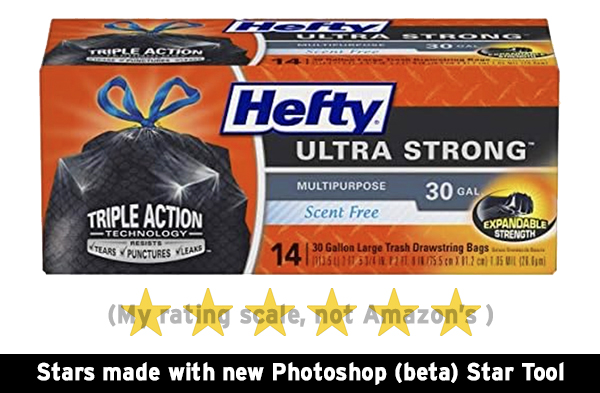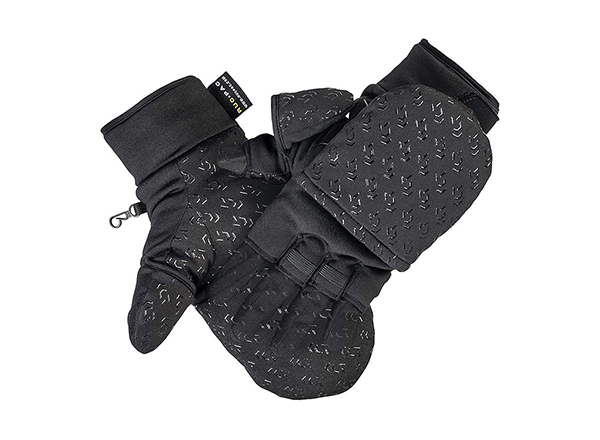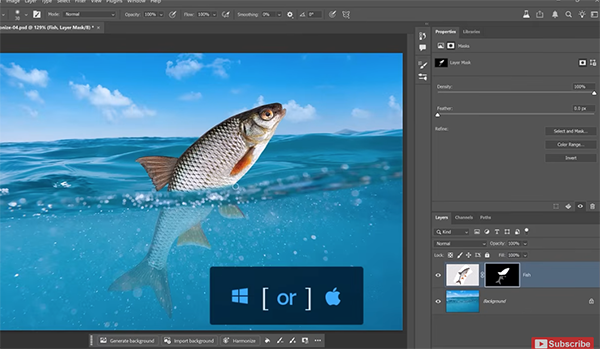When it’s so hot that fire hydrants hold signs that read, “Dogs Welcome!” or so cold that you have to chew your vodka shooter, photographers must take special precautions to maintain focus. Here are the products that are alleged to protect you from everything except arachibutyrophobia (the fear of peanut butter sticking to the roof of your mouth).

Can’t help you with the sticky peanut butter phobia, but here are the Heimlich maneuvers for every adverse weather event. I use each and every one of them often, both personally and professionally, because when it comes to climatic things, I have really rotten luck. In fact, my family made me stay home when they moved to Illinois to assure good traveling weather. Or at least that’s what they told the police.

30-gallon Hefty Garbage Bags
Emergency rainsuit, makeshift weatherproof headcover, last-ditch bushcraft shelter—those are just a few of the many roles a large, good-quality trash bag can play—in addition to providing excellent protection for a bag full of camera gear when the weather turns on you like startled vampire bat.
I prefer Hefty Ultra Strong 30 gallon trash bags, which I buy from Amazon. Price is about $20 for a box of 50, which works out to—what?—about 40¢ each? There are probably equal or better waste sacks out there, but Hefty has never let me down and I recommend them highly. I even use them as poop pick-up pouches when I walk my bison. [He’s lying. The bison roams freely in his backyard and never gets taken for a walk. — Ed.]

Chipmunk Counterterrorism Tactics
It’s widely known around these parts that Eastern chipmunks (Tamias striatus) can be deceptively vicious little rodents with little or no provocation. Interrupt their snooze, disturb their stash of black oil sunflower seeds, or shoo them away from a carrot patch and you may find yourself under attack from a 52-gram (1.8 ounce) ball of fury. With teeth up to 2mm wide, and tails capable of delivering debilitating blows, an urban street chippy is no joke.
The best strategy I have found is to carry pocketsful of acorns. When under attack, sprinkle the oak seeds on the ground to distract the tiny vermin. While he or she is busy stuffing their elasticized cheeks, run like hell. Chipmunks cannot run fast with 7 or 8 acorns in their mouth.
Good luck!
 Weather Protection for Camera & Lens
Weather Protection for Camera & Lens
Peak Design does everything well. Best known for category-leading straps, bags and tripods, they also offer the Shell. Made from form-fitting stretchy fabric, it’s waterproof and oh-so easy to stow in your bag for a rainy day.
Available in three sizes, you can order the M (medium) from Amazon for $54.95. Visit the Official Peak Design Storefront on Amazon to view and buy a wide assortment of PD products.

Got Gloves?
You need gloves to go a round or two with Mother Nature when your teeth are chattering like a cornered politician being grilled by Isobel Yeung, the toughest interviewer in the entire world, IMHO. My favorite are RucPac Professional Tech & Extreme Tech Gloves. The Pro Tech are touchscreen-conductive, so they’re ideal for smartphone photographers. The Extreme Tech gloves are mittens that open to expose gloved or bare fingers. You can wear Professional Tech Gloves inside Extreme Tech Gloves for additional cold weather protection. Available in three sizes, RucPac Extreme Tech Gloves are available from Amazon for $59.99.

Powerbank & Extra Battery
I dig the BioLite 100 Max because it packs a whopping 25,000 mAh into a package that mics out at 5.5 x 4.4 x 1.4 inches (140 x 112 x 35mm) and weighs but 20.5 ounces (580g). You can charge your laptop 1 or 2X, Smartphone 5-7X and just about any other portable that’s USB-C or MagSafe compatible, including those ugly* AirPods. Order from Amazon for $179.95.
Don’t forget a freshly-charged spare battery for your primary camera. You know that drill, so I’m not going into details. Buy the original camera manufacturer’s brand or roll the dice with an unknown name. In all fairness, I’ve had good luck with Wasabi brand aftermarket cells.
* I don’t really think AirPods are ugly, but my ears are too big to use them; hence, I give them the “sour grapes” treatment.

NOAA Weather Radio
Serious now; the next two paragraphs could save your life.
The NOAA Weather Radio system continuously transmits local and regional weather information. This is a great resource when things are good, and it becomes a vital source of accurate, up to the minute info during disasters. They use a range of frequencies clustered around 162.550 MHz. The exact frequency for your area can be found on their website. Since regular AM-FM radios cannot be tuned to this spectrum, you need a weather radio or police scanner.
NOAA transmits an emergency tone that wakes up some specially equipped radios, so if you live in a tornado-prone area, consider a receiver that offers this feature. Some models offer AM, FM and NOAA weather broadcasts, a built-in LED flashlight, USB charger output and a hand crank and/or solar panel for battery-free operation. In a pinch you can charge your phone even under the worst conditions.
Check out the tiny (6 x 3 x 1.8 inch / 15.2 x 7.6 x 4.6cm) portable Midland ER50 (just $44.88 from Amazon) or visit the Official Midland Store at amazon.com. Contrary to what I wrote above, I have not personally used this product. Instead, I use a multi-band scanner that also monitors Police, Fire and Aviation bands.

‘Grab and Go’ External Drive
Keep your important photos, documents, tax records and so forth on an easy-to-find external hard drive so that when the SHTF (Stuff Hits The Fan) you can grab it on your way out the door. I hope you never need it.
My favorite is an orange portable HDD from LaCie. The LaCie Rugged USB-C 4TB model is drop, shock, dust and rain resistant and costs just $146.25 on amazon.com. It’s Mac and Windows compatible, bus-powered (i.e., does not need an external AC adapter), measures a scant 5.3 x 3.4 x 0.7 inches (135.1 x 86 x 18.7mm) and weighs less than a pound. Available in other storage capacities also. And, of course, it’s orange.

Take Note
I write, although you can’t tell by this article. I write in the rain sometimes, too. When I do I use an orange Write in the Rain ballpoint. It’s pretty simple; it writes in the rain. And it’s orange.
It’s $21.95 on Amazon, and that may sound expensive, but hey! It’s orange. They also offer waterproof notebooks and low-fi pencils. Don’t all pencils write in the rain?

Headlamp
If you drive at night, you need a headlamp in the glove box of your car. If you’ve ever changed a tire when it’s darker than a black cat hiding in a coal bin*, you know painfully what I mean.
These days I’m partial to the BioLite HeadLamp 800 Pro. It’s rechargeable and contains a premium 3000 mAh Lithium-ion battery that can last up to a whopping 150 hours in Low Power mode. The BioLite HeadLamp 800 Pro provides a maximum illumination level of 800 lumens. That’s about the same as a 60 Watt incandescent lightbulb. Order from BioLite for $119.95.
* Explainer for Gen Z and some Millennials: In the old, old days, homes were heated with coal (unripe diamonds) which was stored in a special room so that the dust didn’t soil everything in the house. These special rooms were called “bins.” I don’t know why. As a child, I frequently had to walk the several thousand feet through the length of the unlit basement coal bin, at night, in pitch darkness, to fetch a shovel full of fuel. To this day I am afraid of anything shaped like a shovel, which is why I eat soup with a fork.

SPD (Surge Protection Device) &
UPS (Uninterruptable Power Supply)
I covered SPDs in depth a few years ago, and I’m too tired to plagiarize myself now. So read this: 7 Dangerous Misunderstandings About Surge Suppressors that Photographers NEED to Know.
UPSs, or Uninterruptable Power Supplies, sit like a cat (that’s not in a coal bin) ready to pounce the instant it senses that your computer is no longer being fed from the main current. Some UPS units allow you to work for a long period of time, and others barely give you enough time to hit Control-S to save before safely powering down. In any case, it’s better than losing everything to Thor.
The APC BE600M1 Battery Back & Surge Protector ($83.99 from Amazon) is a solid overall choice. It’s one of the few that features replaceable battery cells, and it delivers 330W battery backup power.

A Bag To Put It All In
A weather-resistant bag is obviously a must. Don’t be tempted to use a backpack that’s overly large because it will be too difficult to carry comfortably for more than a minute if you’re running from a tornado. You can probably use a bag you already own, if not, take a quick look at How to Buy a Camera Bag where you’ll find our 10-point checklist of characteristics that help you decide the best bag for your specific needs.

Is Your Weather Resistant, Splashproof, Waterproof Camera Impervious to Water & Dust?
Camera Rain Gear Review
Storm Danger! 7 Things You Need to Quash Electrical Storms
Hot Tips (How Photographers Can Cope with Hot Summer Weather)
Battling the Polar Vortex
How To Buy a Camera Bag


Bug Out Bag
Webster writes that “Bug out” means: “to depart especially in a hurry.” Originally a military term, bugging out is what one does before their position is overrun. Sometimes confused with retreat, it’s actually about survival. It’s doubtful we’ll ever encounter a Mad Max type situation, but the world is becoming less predictable day by day.
In this context, a Bug Out Bag is simply a backpack or sling that contains things you’ll be glad you packed if the really bad stuff brutally hits the fan. Pack the obvious: medicine needed by you and family members, water, ready-to-eat food, flashlight, candles, knife, first aid kit and an extra pair of glasses. Exact contents varies with the individual; think extreme camping trip (but leave out the White Claws) and you’ll quickly come up with an inventory. Ideally, prep a separate Bug Out Bag for each member of the family, including the doggos. (Cats? That’s optional).
Don’t need one? I guess you could always hide in the coal bin.

Stay Home and AI Doodle
As you’ve probably noticed, many of the illustrations in this story were generated by AI. It’s 94º in New York as I write this, and my carbohydrate-based body begins to melt when the mercury passes 80º. At least, that’s my excuse this week.
I also wimp out when it rains or snows, preferring the company of a warm hearth and cool iPad to a weather event.
Too hot or too cold outside?
Stay inside and use someone else’s imagination via the magic of AI.

I’m not even half serious. I grew up around Chicago and worked outdoors in sub-zero weather and blinding lake-effect snowstorms many a day. If you take the proper precautions, you can get great images and videos in nearly any weather. Avoid all floods, earthquakes, volcanic eruptions and Walmart on Black Friday. Run away from those and don’t lose focus.

Oh—also avoid Eastern box turtles (Terrapene carolina carolina), otherwise known as “nature’s 5-inch* armored assassins.” They’re lethargic but lethal when caught unawares. Sadly, there are no known defensive strategies aside from stroking them under the chin and offering them an assortment of live insects or a ripe strawberry.
* Measured diagonally.
—Jon Sienkiewicz
(As an Amazon Associate, Shutterbug earns from qualifying purchases linked in this story.)





 Weather Protection for Camera & Lens
Weather Protection for Camera & Lens


















